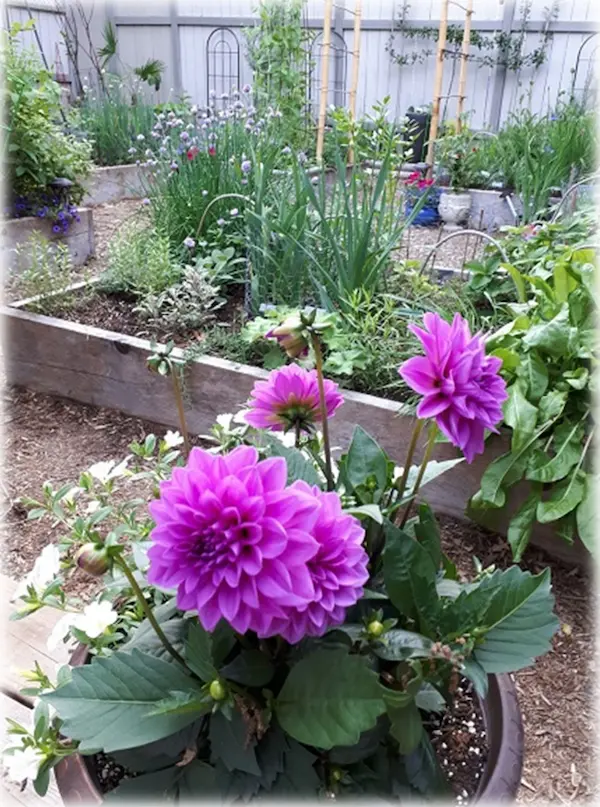Mixing it Up: Combining Edibles with Ornamentals
Photo:
Claire McCaughey
Author: Claire McCaughey, Master Gardeners of Ottawa-Carleton
Just a few decades ago, planting ornamental plants and food crops together would have been frowned upon by the gardening establishment. Gardeners have tended to specialize in growing ornamentals or vegetables in separate beds, with only a few choosing to grow them together. There might have been a justification for this in terms of past specialized growing techniques and practices such as double-digging vegetable beds and spraying roses with pesticides. These techniques and practices, however, are mostly not used any more. With environmental awareness and more naturalistic planting designs becoming the norm, one of the trends in gardening has been towards removing the separation between ornamental and vegetable plants. Individual gardeners, botanical garden managers, and municipal landscape designers have all incorporated some food plants into their ornamental plantings. The result has been surprising, with striking plant combinations as well as a new appreciation for the ornamental qualities of edible plants.
Beautiful Edibles for Ornamental Plantings
Below are some edible plants that are increasingly being used in ornamental flower beds and container plantings:
Beta vulgaris var. cicla (Swiss chard):
Swiss Chard, a vegetable, in addition to being nutritious, has some characteristics that make it beautiful in plantings, especially the vivid colour of the stems. The red, yellow, and orange stems of ‘Bright Lights’ Swiss chard stand out against the leafy green lushness of the plants. This plant grows best in full sun and requires regular watering. It grows to about 45 cm in height and can be grown in containers as well as on the ground. Because of its striking stem colour and large leaves, it can be combined with tropical annuals such as Canna cultivars in summer plantings or with smaller Dahlia pinnata. Chard can be directly sown in the garden or started indoors from seed.
Brassica oleracea (kale):
This is an easy-to-grow annual vegetable (actually a biennial grown as an annual). Different cultivars and species have red, purple, blue-black, or green leaves, which complement and contrast well with flowers in summer plantings. Different varieties grow to different heights, so it is important to check the details for each variety. The largest kale, Lacinato blue, aka “dinosaur” kale, often has exceptionally long leaves that can grow to 1 m long in the right conditions. It is well suited to being combined with larger, bright-coloured flowers. Kale can be started outdoors from seed in the early spring. However, if plants are to be combined with ornamentals, starting the seeds indoors or purchasing plants is the way to go.
Fragaria spp. (strawberry):
Most strawberries have small white flowers, so the main reason for including them with ornamental plants are the trailing stems, or runners, and their red fruits. Sometimes strawberries are grown in hanging baskets on their own as ornamental plants. Most strawberries are short plants (20 cm or less), so they are best used at the edge of large containers with ornamentals or at the front of a flower bed. Strawberries can be started from seed, but for summer containers with flowers, strawberry plants can be purchased.
Ribes rubrum (red currant):
This fruiting shrub produces beautiful clusters of small, round red berries, which are often made into jams or jellies. The flowers and fruit are very ornamental and can therefore be included within a shrub border or as an informal hedge beside an ornamental flower bed. This shrub grows to 1 to 1.5 m and is almost as wide, and it can tolerate some shade. The cultivated shrub also has a wild cousin (Ribes triste) that could be incorporated into a native plant garden.

Other Edible Plants to Consider
Many leafy vegetables, such as Latuca sativa (lettuce), have varieties with red or speckled leaves, which can be incorporated into annual ornamental plantings. Lettuce can be started early in the spring, planted out, and then consumed by early summer. This strategy provides the opportunity for hot weather annuals to be planted later in the area where the lettuce was grown.
Some herbs have ornamental flowers, notably Allium schoenoprasum (chives) with round pink flowers and Anethum graveolens (dill) with yellow flower umbels. A few herbs have colourful leaves, such as Ocimum basilicum ‘Dark Opal’ (basil), which has deep purple leaves, while Salvia officinalis ‘Tricolour’ (sage) has red to purple markings on grey leaves. Common (sage) provides a soft colour contrast in an ornamental bed.
This summer, I recommend that you try to incorporate a few edibles into your ornamental bed. Remember, however, that if you plan to eat the edible plants in your mixed-up garden, then you should ideally grow all plants in the bed organically.







Leave a Reply
You must be logged in to post a comment.